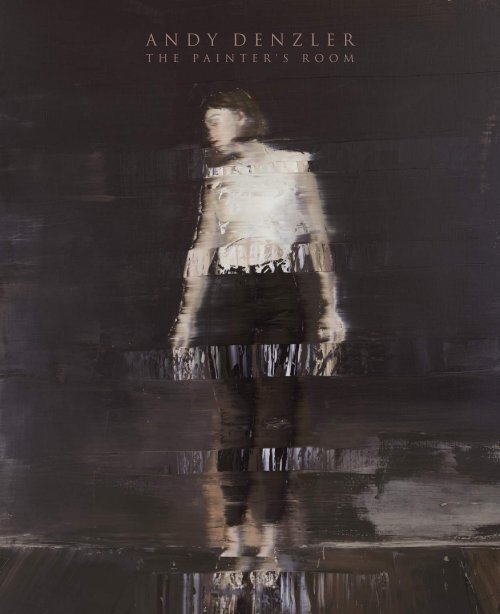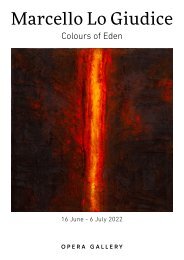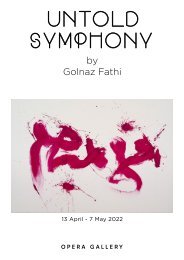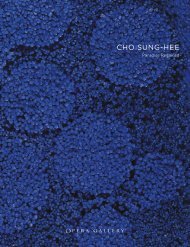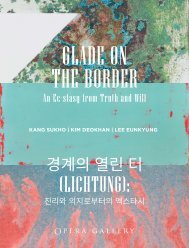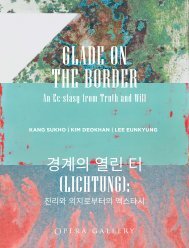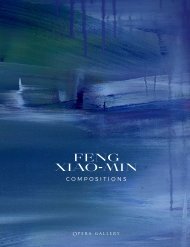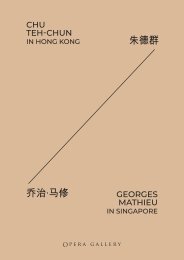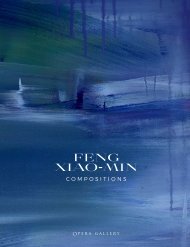You also want an ePaper? Increase the reach of your titles
YUMPU automatically turns print PDFs into web optimized ePapers that Google loves.
ANDY DENZLER<br />
THE PAINTER'S ROOM
ANDY DENZLER<br />
THE PAINTER'S ROOM
ANDY DENZLER<br />
THE PAINTER'S ROOM
PREFACE<br />
À la suite de Genève, Londres, New York et Monaco, nous sommes heureux<br />
d’accueillir en nos murs la nouvelle exposition personnelle de l’artiste suisse<br />
Andy <strong>Denzler</strong> intitulée The Painter’s Room. À cette occasion, un ensemble<br />
d’une trentaine d’œuvres inédites sera présenté au public parisien.<br />
Following Geneva, London, New York and Monaco, we are glad to welcome<br />
Swiss artist Andy <strong>Denzler</strong>’s new solo exhibition, The Painter’s Room.<br />
Around thirty unseen works will be presented to the Parisian audience<br />
on this occasion.<br />
Peintre de l’intime, Andy <strong>Denzler</strong> renoue avec la grande tradition de la<br />
peinture figurative au travers de portraits de modèles anonymes peints dans<br />
son atelier. La représentation de l’être humain dans sa réalité quotidienne<br />
demeure le centre de son œuvre. L’usage singulier de la technique à l’huile<br />
de l’artiste exprime avec brio son attachement à la nature matérielle d’une<br />
œuvre d’art. Sa palette, volontairement restreinte aux couleurs terre, au<br />
noir et au blanc, fuit tout effet d’artifice. Andy <strong>Denzler</strong> nous rappelle ainsi<br />
à quel point un tableau est avant tout une présence singulière dans un<br />
espace donné.<br />
Au delà de sa rétrospective au Musée Ludwig à Coblence en 2014, Andy<br />
<strong>Denzler</strong> expose dans de prestigieuses institutions muséales comme le<br />
Gwangju Museum of Art à Seoul mais aussi lors de Biennales comme à<br />
Marrakech en 2016.<br />
Nous espérons que cette exposition sera l’occasion pour nos collectionneurs<br />
et nos visiteurs de découvrir les qualités créatives d’un artiste remarquable.<br />
A painter of intimate scenes, Andy <strong>Denzler</strong> rekindles with the great figurative<br />
painting tradition through portraits of anonymous models painted in his<br />
studio. Representation of the human being in its daily reality remains the<br />
heart of his works. His singular oil painting technique expresses with verve<br />
the artist’s attachment to the material nature of an artwork. His palette of<br />
colours, voluntarily restrained to earthy tones, black and white, is devoid<br />
of artifices. Andy <strong>Denzler</strong> reminds us how much a painting is a singular<br />
presence in a given space.<br />
Other than his 2014 retrospective at the Ludwig Museum in Koblenz,<br />
Andy <strong>Denzler</strong> has exhibited in prestigious museums such as the Gwangju<br />
Museum of Art in Korea, but also at the Marrakech Biennale in 2016.<br />
We hope that this exhibition will be the opportunity for our collectors<br />
and other visitors to discover the creative qualities of a remarkable artist.<br />
Gilles DYAN<br />
Fondateur et Président, Opera Gallery Group<br />
Gilles DYAN<br />
Chairman and Founder, Opera Gallery Group<br />
Fatiha AMER<br />
Directrice, Opera Gallery Paris<br />
Fatiha AMER<br />
Director, Opera Gallery Paris<br />
2<br />
3
4<br />
4<br />
5
ANDY DENZLER<br />
Texte d’Enguerrand Lascols<br />
Paris, 2018<br />
Né à Zurich en 1965, Andy <strong>Denzler</strong> vit et travaille en Suisse. Après avoir<br />
peint pendant une dizaine d’années des toiles abstraites, inspirées des<br />
expressionnistes abstraits Américains et des artistes géométriques de sa<br />
ville natale tels que Max Bill et Richard Paul Lohse, l’artiste s’est tourné vers<br />
l’étude du mouvement et des distorsions. C’est avec cette intention que,<br />
dès le début des années 2000, ses toiles et ses sculptures ont finalement<br />
adopté un vocabulaire figuratif, qu’il développe encore aujourd’hui dans<br />
son studio zurichois. Après son Master of Fine Arts au Chelsea College of<br />
Art and Design de Londres, ses créations ont fait l’objet de nombreuses<br />
expositions en Europe, aux États-Unis et en Asie. Certaines de ses œuvres<br />
figurent désormais dans de prestigieuses collections privées et publiques,<br />
telles que le Ludwig Museum, le Crédit Suisse ou la Burger Collection à<br />
Hong Kong.<br />
Identifiables au premier regard, les toiles de l’artiste sont le fruit d’une<br />
technique propre qui, à chaque étape, compose peu à peu un monde<br />
particulier. En prenant appui sur ses photographies, Andy <strong>Denzler</strong> prend<br />
pour modèle de jeunes urbains créatifs, des acteurs ainsi que ses proches<br />
et amis. À la peinture à l’huile, couche après couche, leurs visages et leurs<br />
corps se révèlent. Pourtant, cette impression n’est que passagère, car<br />
rapidement, avant que la peinture ne sèche, l’artiste déconstruit sa création.<br />
À l’aide d’une spatule ou d’un couteau, il incise et strie la matière, l’étale ou<br />
l’accumule afin de lui donner un relief inédit. Par cette impulsion artistique,<br />
couleurs et formes fusionnent dans un mouvement rectiligne spécifique.<br />
Une même démarche artistique anime également ses sculptures. Qu’elles<br />
soient de bronze ou de plâtre, elles présentent toutes dans un même esprit<br />
ces distorsions si caractéristiques de son œuvre.<br />
Grâce à cette esthétique originale, ses créations amènent à une rencontre<br />
entre figuration et abstraction. C’est bien l’image d’une femme, d’un homme,<br />
d’un couple, qui se donne à voir à la surface des toiles mêlée à de larges<br />
aplats de couleurs, des surfaces mouvantes, des distorsions où s’entremêlent<br />
les tons à l’arrière du sujet. Utilisant le langage visuel de l’expressionnisme<br />
abstrait des années 1950, Andy <strong>Denzler</strong> y intègre la figure humaine, celle de sa<br />
vie quotidienne, patiemment observée et photographiée. Cette quotidienneté,<br />
<strong>Denzler</strong> l’attaque et la transforme, et ainsi la figuration laisse sa place<br />
à la non-figuration. Le tout est retranscrit dans une palette neutre qu’il<br />
affectionne, composée de couleurs calmes oscillant entre les tons chair,<br />
l’ocre et le brun.<br />
Cette technique expressionniste profondément moderne se combine dans<br />
les travaux d’Andy <strong>Denzler</strong>, à une iconographie toute traditionnelle. Dans<br />
ses portraits en pied comme ses scènes d’intérieur, résonnent les échos<br />
de la peinture ancienne, celle notamment des Italiens et des Flamands du<br />
XVIIe siècle. Ce sont dorénavant nos contemporains qui peuplent chacune<br />
des toiles, des femmes et des hommes ordinaires, capturés dans leurs<br />
instants quotidiens. En peintre de la vie moderne, l’artiste témoigne d’une<br />
attitude à la fois émue et respectueuse devant le réel et donne au banal<br />
une dimension sublime. Alors, dans toute la simplicité et la qualité de son<br />
œuvre, la figure humaine accède à la dignité et la monumentalité. Entre les<br />
thèmes de Vermeer, la fougue de Franz Kline et les aplats de Rothko, Andy<br />
<strong>Denzler</strong> nous transporte à travers les époques et les styles, puisant son<br />
inspiration de toute part. L’art du passé constitue un socle de référence sur<br />
lequel l’artiste s’appuie pour nous livrer toute l’originalité de son univers et<br />
le renouvellement pictural qu’il propose.<br />
Aussi, par ces scènes et portraits fragmentés, Andy <strong>Denzler</strong> s’inscrit dans<br />
une création contemporaine se concentrant sur la figure et sa représentation<br />
dans l’espace. Aux côtés des corps fantomatiques du Britannique Peter Doig<br />
et des grands visages peints à coups de brosse du Chinois Yan Pei-Ming,<br />
6<br />
7
le Suisse portraiture lui aussi l’humain, des femmes et des hommes à la fois<br />
anonymes et individualisés. Ce groupe de peintres internationaux établit par<br />
le biais du figuratif un face-à-face avec l’individu, afin de porter un regard<br />
incisif sur nos sociétés. Dans notre monde de plus en plus saturé d’images,<br />
de tels artistes acquièrent un rôle d’importance en résistant à l’immédiateté<br />
et à l’urgence des nouveaux médias pour donner aux images une nouvelle<br />
temporalité, permettant l’arrêt et invitant à la réflexion et à la méditation.<br />
C’est bien ce rapport au temps qui caractérise l’œuvre d’Andy <strong>Denzler</strong>. Dans<br />
l’acte créateur tout d’abord, lorsque le peintre doit rapidement dompter<br />
la matière avant qu’elle ne sèche. Dans la toile, physiquement, qui laisse<br />
apparaître ses couches primitives. Dans la représentation elle-même, enfin,<br />
striée de toute part comme les télévisions d’autrefois lorsque la cassette<br />
VHS était mise sur pause. Tout à coup, la scène à l’écran, l’image sur la toile,<br />
est traversée par de multiples sillons. Entre la seconde précédente et la<br />
seconde suivante, le temps s’arrête. Quelque chose a été, quelque chose<br />
va venir mais, pour le moment, tout se fige.<br />
Nous prenons alors le temps de regarder, de contempler une scène quotidienne<br />
qui pourrait sembler commune et ordinaire mais qui en réalité constitue<br />
un moment passager et furtif rempli de multiples nuances et de couleurs<br />
changeantes. Andy <strong>Denzler</strong> nous dévoile les différentes facettes d’un monde<br />
mis à l’arrêt en nous faisant voir ce qu’habituellement nous ne savons voir.<br />
Il dévoile une réalité concrète que seule son attention a pu mettre au jour.<br />
Chaque toile, chaque sculpture, devient alors un moment suspendu, un<br />
instant unique.<br />
Page right:<br />
Andy <strong>Denzler</strong>'s studio view, 2018<br />
8 9
ANDY DENZLER<br />
Text of Enguerrand Lascols<br />
Paris, 2018<br />
Born in Zurich in 1965, Andy <strong>Denzler</strong> lives and works in Switzerland. After<br />
painting abstract works for over a decade, inspired by the American Abstract<br />
Expressionists and Geometric Abstraction artists from his hometown, such<br />
as Max Bill and Richard Paul Lohse, the artist began exploring the idea of<br />
movement and distortion in his work. In the early 2000s, his work became<br />
figurative, a visual language which he continues to explore and develop<br />
to this day in his studio in Zurich. After completing a Masters of Fine Arts<br />
degree at the Chelsea College of Art and Design in London, his work was<br />
exhibited in many different galleries and institutions in Europe, in the<br />
United States and in Asia. Some of his pieces now belong to prestigious<br />
private and public collections such as the Ludwig Museum, the Crédit<br />
Suisse Collection in Switzerland or the Burger Collection in Hong Kong.<br />
<strong>Denzler</strong>’s work is recognisable at first glance; his paintings reveal his very<br />
unique style, a whole different world. By taking inspiration from his personal<br />
photographs of young urban creatives such as models, actors or friends,<br />
<strong>Denzler</strong> slowly divulges through each layer of paint the faces and bodies<br />
of his subjects. While the paint is still wet, the artist uses a spatula and<br />
a painting knife to incise, streak and spread the matter in order to create<br />
texture. Colour and form fuse in a specific rectilinear movement. In his<br />
sculptures, using bronze and plaster, <strong>Denzler</strong> continues to distort his works.<br />
As a result of this original aesthetic, <strong>Denzler</strong>’s creations merge the figurative<br />
and the abstract. It is, in fact, the picture of a woman, a man, a couple that<br />
one can see on the surface of the canvas combined with large coloured<br />
areas, moving surfaces and distortions. <strong>Denzler</strong> integrates figures and scenes<br />
from everyday life as captured through photography. Thus, figuration leaves<br />
room to non-figuration and all is united in a neutral palette, composed of<br />
more subdued colors such as flesh tones, ochres and browns.<br />
<strong>Denzler</strong>’s iconography is in a sense traditional. His portraits and interior<br />
scenes are reminiscent of old paintings, particularly Italian and Flemish<br />
of the 17 th century. His paintings depict ordinary men and women in their<br />
daily routines. The artist always approaches each subject with great respect<br />
and admiration, giving them a sublime dimension. Through the simplicity<br />
and quality of his work, the human figure becomes dignified and grand.<br />
Influenced by Vermeer’s themes, Franz Kline’s gusto and Rothko’s colour<br />
fields, <strong>Denzler</strong> takes us on a journey through time. This art from the past<br />
is a foundation from which the artist draws to bring us the originality of<br />
his universe and new pictorial work.<br />
With his fragmented interior scenes and portraits, Andy <strong>Denzler</strong> is part<br />
of a group of contemporary artists who concentrate on figures and their<br />
representation in space. Not unlike Peter Doig’s ghostly figures or Yan<br />
Pei-Ming’s portraits painted with large brush strokes, <strong>Denzler</strong> paints the<br />
human figure - men and women who are anonymous and individualised<br />
at the same time. This group of international artists cast an insightful eye<br />
on our society through their figurative work. In our world overloaded with<br />
images, such artists were able to resist to the immediacy and urgency<br />
that the new media have to offer and give their images a new temporality,<br />
allowing the viewer to reflect and contemplate.<br />
This relationship with time is reflected in Andy <strong>Denzler</strong>’s work: first in<br />
his painting process as the artist must subdue the paint before it dries;<br />
then on the canvas itself which shows its underlying layers and finally in<br />
the picture, which is striated just like the old television screens when you<br />
pressed pause on a VHS player. All of a sudden, the scene on the screen or<br />
the image on the canvas are lined with multiple streaks. From one second<br />
to another, time stops. Something has happened or something is going to<br />
happen, but for now, everything is frozen.<br />
10<br />
11
We take the time to contemplate an ordinary scene by looking at it through<br />
the artist’s subtle lens filled with different shades and changing colours.<br />
Andy <strong>Denzler</strong> makes us discover the world through a different perspective.<br />
He unveils a new concrete reality. Each canvas, each sculpture becomes<br />
a moment suspended in time, a unique experience.<br />
Page right:<br />
Torso in Motion, 2018<br />
Oil on canvas<br />
120 x 140 cm I 47.2 x 55.1 in<br />
12<br />
13
14<br />
15
INTERVIEW<br />
d’Andy <strong>Denzler</strong> par David Rosenberg<br />
1. Par votre utilisation de la peinture à l’huile et une représentation figurative,<br />
votre travail est directement lié à une longue tradition de l’histoire de l’art,<br />
plus particulièrement la peinture de genre. Comment vous situez-vous par<br />
rapport à cette tradition ?<br />
Tout d’abord je me vois comme un peintre au sens large et non comme<br />
seulement un peintre figuratif. Ce qui m’intéresse, c’est de capturer la chair<br />
et la forme dans une atmosphère particulière. Mon travail est comparable à<br />
l’art du portrait traditionnel mais il est réalisé avec une gestuelle différente<br />
par l’application de multiples couches de peinture et leur retrait subséquent.<br />
L’identité de chaque modèle est ainsi renforcée par cette gestuelle. Cela<br />
rend les personnes représentées beaucoup plus vulnérables et rappelle le<br />
caractère éphémère de notre existence. Tout est dans la peinture et son<br />
processus. J’essaie de créer une connexion entre le spectateur et le sujet.<br />
Tout est dans l’esthétique et le plaisir sensuel que procure l’action de peindre.<br />
2. Comment avez-vous défini votre style vis-à-vis de la figuration et de la<br />
peinture de genre ?<br />
Mon processus créatif est tellement compliqué qu’il ne peut être expliqué<br />
d’une manière succincte. Je commence toujours avec une idée ou un concept<br />
général qui m’intéresse. Par exemple, après la catastrophe de Fukushima,<br />
j’ai commencé les Zones Paintings qui relataient des tragédies humaines<br />
contemporaines. J’ai commencé en faisant des collages de photos d’usines<br />
désaffectées qui symbolisaient l’ère post-industrielle et j’y ai ensuite placé des<br />
figures humaines que j’ai distordues, comparables à une image directement<br />
composée sur la toile.<br />
4. Vous êtes aussi un sculpteur. Pensez-vous que vos sculptures soient<br />
l’extension naturelle de vos peintures ?<br />
Mes sculptures représentent la suite logique de mes peintures car je<br />
travaille la cire chaude de la même manière que je travaille la peinture à<br />
l’huile. Pour cela, les sculptures reflètent bien l’aspect tridimensionnel<br />
de mon travail. Ce qui est aussi sympathique pour moi avec la sculpture,<br />
c’est que je travaille en équipe dans une fonderie. Cela me fait donc sortir<br />
de l’atelier.<br />
Au début de ma carrière, je faisais plutôt de la peinture abstraite jusqu’à<br />
ce que je trouve mon propre langage visuel. J’ai été très influencé par les<br />
expressionnistes abstraits américains des années 1950 et les artistes<br />
géométriques zurichois tels que Max Bill ou Paul Lohse. J’ai fait de la<br />
peinture abstraite pendant plus d’une décennie. Pendant cette période,<br />
je me cherchais. Venant de la génération du multimédia et de la vidéo, j’ai<br />
alors tenté de capturer dans ma peinture le mouvement et la distorsion,<br />
que pouvaient provoquer ces outils. C’est en 2001 que j’ai commencé à<br />
transposer les éléments photographiques de ma peinture abstraite dans<br />
des portraits. Un an plus tard, j’ai réussi à trouver ma voie dans une peinture<br />
figurative qui conservait une connotation abstraite.<br />
5. Vous avez été designer graphique et vous êtes issu d’une génération<br />
baignée dans les nouveaux médias et les images numériques. On a dit de<br />
vos œuvres qu’elles dégagent une ambiance cinématographique, rappelant<br />
une époque révolue. Pouvez-vous nous en parler ?<br />
De manière générale, mes peintures reflètent la société contemporaine dans<br />
laquelle nous vivons. Je lutte contre la superficialité des images Jpeg et<br />
l’aspect lisse que l’on donne du quotidien. Mais ceci dit, étant de la génération<br />
des nouveaux médias, mon œuvre peut être associée au mouvement des<br />
Cinematic Paintings et à la tension qu’il exprime entre les opposés : entre<br />
l’individu et la société, entre la liberté et l’ordre.<br />
3. Votre travail récent est basé sur des collages faits à partir de vos propres<br />
photographies. Comment composez-vous chaque tableau ? Pouvez-vous<br />
nous en dire plus sur votre processus créatif ?<br />
6. La distorsion est un élément important de votre travail. De quelle façon<br />
faites-vous émerger les émotions de vos images déformées ?<br />
16<br />
17
Je pense qu’il est important de garder un équilibre entre les parties déformées<br />
d’une image et la réalité elle-même. Quand une image est déformée, on<br />
ressent non seulement le temps et l’arrêt du temps dans le mouvement<br />
mais cela invite aussi le spectateur à y projeter ses propres fantasmes et<br />
ses propres émotions.<br />
sont des composantes importantes de mon travail, je préfère être suggestif<br />
au mieux et faire ressentir une émotion ou une atmosphère. L’histoire ne<br />
doit pas être révélée au spectateur, elle s’est arrêtée dans le temps. Le<br />
spectateur ne doit pas être attentif à l’histoire contée mais à l’émotion qui<br />
se dégage de mon travail.<br />
7. Votre peinture a une vraie force visuelle. Cependant, quelque chose d’autre<br />
en émane : le silence. Dans une certaine synesthésie, votre travail évoque<br />
le calme, le secret et comme un sentiment mélancolique. C’est quelque<br />
chose que vous recherchez ?<br />
J’essaie de créer une certaine atmosphère de silence dans mes images avec<br />
la figure humaine au centre de mes compositions. Dans mes toiles, ces jeunes<br />
urbains créatifs sont contemplatifs dans un monde qui leur appartient.<br />
Plutôt que de parler de synesthésie, je préfère parler de l’existence humaine<br />
juxtaposée à une réalité virtuelle.<br />
8. Le temps est un élément important dans vos tableaux. Quelle est votre<br />
relation au temps ?<br />
C’est vrai que le temps est un élément important pour moi car je peins en<br />
utilisant la technique alla prima. Le temps joue aussi un rôle dans la façon<br />
dont un tableau prend forme par rapport à la technique que j’utilise. Je<br />
peins mouillé-sur-mouillé avec d’épaisses couches d’empâtements, donc<br />
forcément je suis soumis aux contraintes du temps, je dois être patient<br />
avec la peinture à l’huile.<br />
10. Que représente la peinture pour vous ?<br />
La peinture existe depuis des millénaires. Pour moi, la peinture est la reine<br />
des disciplines artistiques et elle ne disparaîtra jamais. Personnellement,<br />
je ne veux pas faire de la peinture purement décorative. Je veux garder<br />
mes tableaux vivants, frais et spontanés. Si un tableau captive et trouble<br />
à la fois et s’il étonne de par sa sensualité, alors il n’y a pas de création<br />
humaine comparable.<br />
11. Quels sont les autres sujets que vous souhaitez explorer dans le futur ?<br />
Envisagez-vous de varier les sujets, couleurs ou peut-être la taille de vos<br />
œuvres ?<br />
Bien sûr, j’essaye de développer mon langage visuel et d’explorer plus<br />
en profondeur les relations qui existent entre la nature humaine et sa<br />
représentation figurative à la surface de la toile. C’est comme créer une<br />
réalité ou une hyper réalité sur une toile. Je suis mes instincts, puise dans<br />
les sujets qui m’intéressent et utilise la photographie pour trouver mon<br />
inspiration. Je souhaite utiliser mon appareil photo tel un carnet de croquis<br />
pour explorer de nouvelles perspectives artistiques.<br />
9. Votre travail se réfère-t-il à des moments précis du passé ou est–il hors<br />
du temps ?<br />
Je vois mon travail comme un scénario hors du temps. J’aime aussi que mes<br />
œuvres paraissent comme si elles avaient été peintes il y a 50 ans, un peu<br />
à la manière de Munch qui accrochait ses tableaux à des pommiers pour<br />
leur donner un aspect plus ancien. Même si la distorsion et le mouvement<br />
18<br />
19
15<br />
20<br />
21
INTERVIEW<br />
of Andy <strong>Denzler</strong> by David Rosenberg<br />
1. By using oil paint as your medium and human representation, your work<br />
is directly linked to a long history of art, especially ‘genre painting’. How<br />
do you place yourself in this important tradition?<br />
First of all, I see myself as a painter in general, not particularly as a figurative<br />
painter. I’m more interested to capture the human flesh and figure in a certain<br />
atmosphere. My works respond to traditional portrait painting through an<br />
expressive and multi-layered application of paint and the subsequent removal<br />
thereof. The identity of each protagonist is strengthened by the haptic/<br />
direct intervention. This makes the people who are portrayed appear much<br />
more vulnerable. Ultimately, it serves as a reminder to the vulnerability and<br />
transience of our existence. It is all about pure painting and the process<br />
of painting. I try to create an emotional connection between the viewer<br />
and the subject. It is about aesthetics and the refined sensual pleasure<br />
that ‘painting’ has to offer. There is no difference if I am decomposing the<br />
landscape of nature or human figures in portraiture.<br />
2. Can you talk a bit more about how you’ve personally come to establish<br />
this very unique style between figure and genre painting?<br />
There are so many steps in my studio practice that cannot be explained<br />
in brief. I begin with a general idea or concept that interests me. For<br />
example, after the nuclear disaster of Fukushima, I started the Zone<br />
Paintings that revolved around human tragedies. I started with a collage<br />
of several images from abandoned industrial buildings symbolising the<br />
post-industrial era. With a kind of glitch and distortion, I decomposed<br />
the human figure in my own way and incorporated it into the composition,<br />
which invokes the digital age. That can best be explained as picture<br />
composing directly on canvas.<br />
4. You are also a sculptor. Is it something totally different in its process<br />
or is it a continuity from your paintings? Could you talk about this part of<br />
your work?<br />
It is definitely a continuity from my paintings and a similar approach to the<br />
way I treat the oil paint on canvas and the hot wax on the sculpture. The<br />
beauty about sculpting is that I can work in a team in the foundry to get out<br />
of my studio once in a while. The sculptures show a different perspective<br />
in 3D about my work.<br />
In the beginning, I experimented a lot in the abstract non-figurative field to<br />
find my own visual language. Influenced by American Abstract Expressionists<br />
from the 50s and the geometric Zurich artists like Max Bill and Paul Lohse,<br />
I was painting abstract works for more than a decade. During that period<br />
I tried to develop my visual language further. Coming from a generation of<br />
new media, video and computer graphics, I was inspired to capture motion<br />
and distortion in painting. In 2001, when my work was still non-figurative, I<br />
thought about translating the photographic element of my abstract paintings<br />
into a portrait with a similar fresh brush stroke. A year later, I achieved this<br />
transformation into figurative art with an abstract connotation.<br />
3. Your recent compositions are based on collages from your own photography.<br />
How do you decide to compose each painting? Could you explain a little<br />
bit more about your creative process?<br />
5. Coming from a generation immersed in new media and computer graphics<br />
usage, some say your artworks convey a cinematic feel that reminds the<br />
viewer of a past era. How relatable do you think your artworks are to today’s<br />
visual society?<br />
In the broader sense my paintings reflect the society we all live in today.<br />
I’m totally working against the so called jpg-aesthetics and slickness in<br />
everyday life. On the other hand, my works are affected by the new media<br />
and they may be associated with New Cinematic Paintings as well as its<br />
tension between polar opposites, which have always influenced my paintings:<br />
between the individual and society, between freedom and order.<br />
6. In your visual language, distortion holds a prominent role. How do you<br />
balance between the distorted images and emotions in your paintings?<br />
22<br />
23
I think it is essential to keep the balance between parts of the distorted<br />
and disrupted image and the reality itself. Applying distortion across a<br />
composition, one not only feels time or the halt of time through the movement,<br />
but is invited to project one’s own narrative or emotions.<br />
7. When we talk about synesthesia, the visual effect is obvious in your<br />
work but something else emerges from your canvas: the silence. Your work<br />
evokes quietness, such as a sentiment of melancholy. Is it something you<br />
look forward to convey?<br />
I try to create a certain silent mood and atmosphere in the image which<br />
involves the human figure in the center of my work. These young urban<br />
creatives are contemplating their own private space or world. When we<br />
talk about synesthesia, I prefer speaking about the existence of humans<br />
in juxtaposition to a kind of virtual reality.<br />
8. The essence of time is crucial in your paintings. What is your relationship<br />
with time?<br />
For sure, time is particularly relevant in my painting process as I am working<br />
alla prima. Time also plays a role in how a piece takes shape – in my technique<br />
and process. Because paint wet-on-wet with thick layers of heavy impasto,<br />
the process is very time-sensitive. You have to be patient to paint in oil on<br />
canvas.<br />
an expressive documentation of plausible situations, but that are also aloof<br />
and distanced, in which the viewer must not be distracted by the narrative, and<br />
where he may engage with the expression, material and execution of the work.<br />
10. How do you contemplate the intimate and introspective take on painting<br />
both as a painter and from a broader perspective?<br />
Painting has existed for thousands of years. I believe that in the art world<br />
painting is still the king’s discipline and will never disappear. For me,<br />
personally it is essential that I’m not trying to paint pretty paintings in a<br />
decorative sense. I want to keep the painting alive, fresh and spontaneous.<br />
If the work is captivating and hauntingly beautiful and if it amazes with its<br />
sensual touch, then is nothing comparable that humans can create.<br />
11. What are some other themes you would like to explore in your future<br />
works? Are we looking at variations on themes, colours or perhaps scale?<br />
Of course, I try to develop my visual language further towards the relation<br />
between human nature and figures that accentuate human existence on the<br />
surface of a canvas. It’s like creating a reality or hyper-reality on canvas. I<br />
follow my instincts and personal interests like my own source material and<br />
photography. My intention is to use the camera more as a digital sketchbook<br />
for my paintings to explore new worlds in the field of visual arts.<br />
9. Do you try to express across paintings visions and perceptions of past<br />
moments or are they meant to stand for more timeless qualities?<br />
I see my work in a timeless scenario. I also appreciate the look as if the works<br />
have been painted 50 years ago, similar to Munch’s work when he was hanging<br />
his paintings into apple trees to accelerate the ageing process. As much as<br />
I am concerned with distortion and movement, I prefer to be suggestive at<br />
most, implying only a mood or feeling. Any type of moralizing or story telling is<br />
intended to be frozen, inert, unrevealed to the viewer. I am generally going after<br />
24<br />
25
15<br />
26<br />
27
The Painter's Room II, 2018<br />
Oil on canvas<br />
210 x 180 cm I 82.7 x 70.9 in<br />
28<br />
29
Black Painter's Room, 2018<br />
Oil on canvas<br />
210 x 180 cm I 82.7 x 70.9 in<br />
30<br />
31
After the Dog Walk, 2018<br />
Oil on canvas<br />
150 x 200 cm I 59 x 78.7 in<br />
32<br />
33
Woman with 60s Chair, 2018<br />
Oil on canvas<br />
150 x 200 cm I 59 x 78.7 in<br />
34<br />
35
36<br />
37
Venice Beach I, 2018<br />
Oil on canvas<br />
210 x 180 cm I 82.7 x 70.8 in<br />
38<br />
39
Sleepwalker II, 2018<br />
Diptych<br />
Oil on canvas<br />
200 x 300 cm I 78.7 x 118.1 in<br />
40
Indian Red, 2018<br />
Oil on canvas<br />
120 x 140 cm I 47.2 x 55.1 in<br />
42<br />
43
Venice Beach II, 2018<br />
Oil on canvas<br />
120 x 140 cm I 47.2 x 55.1 in<br />
44<br />
45
Venice Beach III, 2018<br />
Oil on canvas<br />
180 x 150 cm I 70.7 x 59.1 in<br />
46<br />
47
Torso in Motion, 2018<br />
Oil on canvas<br />
120 x 140 cm I 47.2 x 55.1 in<br />
48<br />
49
Study for the Painter's Room II, 2018<br />
Oil on canvas<br />
80 x 70 cm I 31.5 x 27.5 in<br />
50<br />
51
Young Roman, 2018<br />
Oil on canvas<br />
80 x 70 cm I 31.5 x 27.5 in<br />
53
Study for Liquid Beard, 2018<br />
Oil on canvas<br />
80 x 70 cm I 31.5 x 27.5 in<br />
54<br />
55
Golden Hands on Black, 2018<br />
Oil on canvas<br />
210 x 180 cm I 82.7 x 70.9 in<br />
56
Study for the Painter's Room IV, 2018<br />
Oil on canvas<br />
50 x 40 cm I 19.7 x 15.7 in<br />
58<br />
59
Study for the Painter's Room IV, 2018<br />
Oil on canvas<br />
60 x 50 cm I 23.6 x 19.7 in<br />
60<br />
61
62
The Painter's Room VI, 2018<br />
Oil on canvas<br />
150 x 200 cm I 59 x 78.7 in<br />
64<br />
65
Study for the Painter's Room III, 2018<br />
Oil on canvas<br />
50 x 40 cm I 19.7 x 15.7 in<br />
66<br />
67
Study for Torso in Motion, 2017<br />
Oil on canvas<br />
60 x 50 cm I 23.6 x 19.7 in<br />
68<br />
69
Woman's Head with Chaise Lounge, 2018<br />
Oil on canvas<br />
60 x 50 cm I 23.6 x 19.7 in<br />
70<br />
71
The Painter's Room IV, 2018<br />
Triptych<br />
Oil on canvas<br />
200 x 450 cm I 78.7 x 177.2 in<br />
72
The Painter's Room V, 2018<br />
Triptych<br />
Oil on canvas<br />
180 x 450 cm I 70.8 x 177.2 in<br />
75
Study for Billie Jean III, 2018<br />
Oil on canvas<br />
60 x 50 cm I 23.6 x 19.7 in<br />
76<br />
77
Study for Billie Jean II, 2018<br />
Oil on canvas<br />
60 x 50 cm I 23.6 x 19.7 in<br />
78<br />
79
Billie Jean V, 2018<br />
Oil on canvas<br />
140 x 120 cm I 55.1 x 47.2 in<br />
80<br />
81
The Painter's Room III, 2018<br />
Oil on canvas<br />
210 x 180 cm I 82.6 x 70.9 in<br />
83
84<br />
85
Devotional Girl, 2016<br />
Brass, edition of 6<br />
80 x 39 x 30 cm I 31.5 x 15.4 x 11.8 in<br />
86
Black Selfie, 2016<br />
Bronze, edition of 3 + 2 AP<br />
130 x 45 x 37 cm I 51.2 x 17.7 x 14.6 in<br />
88
Selfportrait, 2009<br />
Bronze, edition of 3 + 2 AP<br />
63 x 22 x 18cm I 24.8 x 8.7 x 7.1 in<br />
90
Standing Women Casual, 2014<br />
Bronze, edition of 6 + 2 AP<br />
37 x 10 x 6 cm I 14.6 x 3.9 x 2.4 in<br />
92
Walking woman with bag & scarf, 2014<br />
Bronze, edition of 6 + 2 AP<br />
37 x 10 x 6 cm I 14.6 x 3.9 x 2.4 in<br />
94
Bust II, 2015<br />
Bronze, edition of 6<br />
28 x 24 x 16 cm I 11 x 9.4 x 6.3 in<br />
96
Untitled Sculpture, 2008<br />
Bronze, edition of 6 + 1 AP<br />
62 x 22 x 18 cm I 24.4 x 8.7 x 7.1 in<br />
98
101
Study for Black Hands, 2017<br />
Heliogravure on paper, edition of 23 + 2 AP<br />
75 x 62 cm I 29.5 x 24.4 in<br />
102<br />
103
Study for Girl with White Shoes, 2017<br />
Heliogravure on paper, edition of 23 + 2 AP<br />
75 x 62 cm I 29.5 x 24.4 in<br />
104<br />
105
Study for Natural Affection, 2017<br />
Heliogravure on paper, edition of 23 + 2 AP<br />
75 x 62 cm I 29.5 x 24.4 in<br />
106<br />
107
BIOGRAPHY<br />
1965 Born in Zurich<br />
Lives and works in Zurich<br />
EDUCATION<br />
2006 Master of Fine Arts, Chelsea College of Art and Design, London<br />
2000 Art Center of Design, Pasadena<br />
1999 F&F Schule für Gestaltung, Zurich<br />
University of California, Los Angeles<br />
1981 Kunstgewerbeschule, Zurich<br />
GRANTS/AWARDS<br />
2014 International Artist Residency, Art Factory, Budapest<br />
1997 Ernst Göhner Stiftung, Zug<br />
1996 Cassinelli-Vogel-Stiftung, Zurich<br />
Erziehungsdirektion des Kantons, Zurich<br />
BIENNALES<br />
2016 Not New Now, Marrakech Biennale 6, Marrakech<br />
2015 Memory and Dream, 6 th Beijing International Art Biennale, Beijing<br />
SELECTED SOLO EXHIBITIONS<br />
2018 The Painter’s Room, Opera Gallery, Paris<br />
2017 Fragmented Identity, Opera Gallery, Monaco<br />
Fragmented Figures, Schultz Contemporary, Berlin<br />
2016 Random Noise, Fabian & Claude Walter Galerie, Zurich<br />
Suspended Reality, Opera Gallery, New York<br />
Between Here and There, Opera Gallery, London<br />
2015 Breakfast with Velázquez, Michael Schultz Gallery, Berlin<br />
Just Another Day in Paradise, Brotkunsthalle, Vienna<br />
Sequences, Opera Gallery, Geneva<br />
Figures & Interiors, Ludwig Galerie Schloss Oberhausen, Oberhausen<br />
2014 Distorted Moments, Ludwig Museum, Koblenz<br />
The Forgotten Palace, Budapest Art Factory, Budapest<br />
109
Under My Skin, Fabian & Claude Walter Galerie, Zurich<br />
Between the Fragments, Claire Oliver Gallery, New York<br />
2013 Disolution & Resolution, Kunstraum Osper, Cologne<br />
Empire Inc., Kunsthalle Rostock, Rostock<br />
2012 Interior/Exterior, Michael Schultz Gallery, Berlin<br />
The Sounds of Silence and Distortion, Claire Oliver Gallery, New York<br />
Shifting Landscapes, Kunsthalle Dresden, Dresden<br />
Disturbia, Michael Schultz Gallery, Seoul<br />
Developing Landscapes, Gwangju Museum of Art, Gwangju<br />
2011 Dissonance & Contemplation, Claire Oliver Gallery, New York<br />
Freeze Frame, Michael Schultz Gallery, Seoul<br />
Interiors, Fabian & Claude Walter Galerie, Zurich<br />
2010 The Human Nature Project, Schultz Contemporary, Berlin<br />
Distorted Fragments, Art + Art Gallery, Moscow<br />
2008 Shortcuts, Fabian & Claude Walter Galerie, Zurich<br />
A Day at the Shore, Ruth Bachofner Gallery, Los Angeles<br />
Insomnia, Galeria Filomena Soares, Lisbon<br />
2006 Fusion Paintings, Ruth Bachofner Gallery, Los Angeles<br />
Moon Safari, Chelsea College, University of the Arts, London<br />
2005 American Paintings, Kashya Hildebrand, New York<br />
2004 Blur Motion Abstracts, Ruth Bachofner Gallery, Los Angeles<br />
2002 White Paintings, Ruth Bachofner Gallery, Los Angeles<br />
2013 Obscure, Fabian & Claude Walter Galerie, Villa Renata, Basel<br />
Salondergegenwart, Hamburg<br />
Bosporus Brake, BAP Galleri, Istanbul<br />
O.T., World Art Museum, Beijing<br />
Infinity - Neoexpressionism / Contemporary Art, Zhan Zhou<br />
International Cultural and Creative Industry Park, Beijing<br />
2012 Beyond Bling, Claire Oliver Gallery, New York<br />
Abgrund und Pathos, Schultz Contemporary, Berlin<br />
Beyond the Paramount, Galerie Michael Janssen, Berlin<br />
2011 10-20-10, Claire Oliver Gallery, New York<br />
Surface, Claire Oliver Gallery, New York<br />
2010 Silly Gooses Live in The Dark, UF6 Projects, Berlin<br />
The Big World, Fabian & Claude Walter Galerie, Zurich<br />
2009 Nursery Rhymes, Flowers East, London<br />
The Beautiful Painting Show, Fabian & Claude Walter Galerie, Zurich<br />
The Lure and The Seducer, Christoffer Egelund Gallery, Copenhagen<br />
White Show, Ruth Bachofner Gallery, Los Angeles<br />
2008 Future50, PSL Project Space, Leeds<br />
Kapellmeister Pulls A Doozy, Seven Seven, London<br />
Unnatural Habitats, Flowers East, London<br />
2007 Kindheit, Museum Rohnerhaus, Lauterach<br />
Anticipation, One One One, Flora Fairbairn Projects, London<br />
Dorian Gray Projects, John Jones Project Space, London<br />
2005 Summer Exhibition, Ruth Bachofner Gallery, Los Angeles<br />
SELECTED GROUP EXHIBITIONS<br />
2018 Painted Images, Sanatorium, Istanbul<br />
Portrait, Opera Gallery, New York<br />
2017 Painting, Leeahn Gallery, Daegu<br />
Autumn Leaves, Michael Schultz Gallery, Berlin<br />
Transit, Michael Schultz Gallery, Berlin<br />
2016 Creative Frenzy, Schultz Contemporary, Berlin<br />
Monochromaniac, Opera Gallery, New York<br />
Thirty Year Anniversary, Fabian & Claude Walter Galerie, Zurich<br />
Addicted to Painting, Michael Schultz Gallery, Berlin<br />
Something, Berry Campbell, New York<br />
2015 Imago Mundi, Luciano Benetton Collection,<br />
Fondazione Giorgi Cini, Venice<br />
Dancer in the Dark, Schultz Contemporary, Berlin<br />
2014 Wunderkammer, Fabian & Claude Walter Galerie, Zurich<br />
The Weekly Show, Schultz Contemporary, Berlin<br />
In|Outsource, Amnua Museum, Nanjing<br />
Wild Heart: Art Exhibition of German Neo Expressionism Since<br />
the 1960s, China Art Museum, Shanghai<br />
PROJECTS<br />
2008 Future50 PSL Project Space, Leeds, curated by Ceri Hand and Liz Aston<br />
2007 Dorian Gray Project, John Jones Project Space, London<br />
Anticipation, One One One, Flora Fairbairn Projects, London,<br />
curated by Flora Fairbairn, Kay Saatchi and Catriona Warren<br />
REVIEWS & PUBLICATIONS<br />
2016 Noah Becker: Suspended Reality, Opera Gallery NY, (<strong>catalogue</strong>),<br />
October<br />
Sohei Oshiro: Motion & Distrotion, Them Magazine, June<br />
Noah Becker: Between Here and There, White Hot Magazine, May<br />
Noah Becker: Between Here and There, Opera Gallery London,<br />
(<strong>catalogue</strong>), May<br />
110<br />
111
2015 Christoph Tannert: The Granular Surfaces of Painting,<br />
Schultz Contemporary, Berlin, (<strong>catalogue</strong>), November<br />
Andreas Reusch: Figures & Interiors: Die Störung des Klaren<br />
Blickes, Schraege-O, June<br />
Andrea Micke: Bildstörung in der Ludwiggalerie Neue<br />
Kunstverein Ausstellung, WAZ, May<br />
Jordan Lahmi: Sequences, Opera Gallery, Geneva, (<strong>catalogue</strong>), May<br />
Sasha Graybosh: Risk is Central to the Concept of Adventure,<br />
Canteen, May<br />
May Karin Dubert: Verzerrte Momente, Wochen Anzeiger<br />
Oberhausen, May<br />
Daniele Giustolisi: Andy <strong>Denzler</strong> in der Ludwiggalerie im<br />
Schloss Oberhausen, May<br />
Susanne Braun: Distorted Moments, Portal Kunstgeschichte, January<br />
2014 Ildegarda Scheidegger: The Power of the Painted Image,<br />
Ludwig Museum, (monograph), December<br />
Beate Reifenscheid: Distorted Moments, Ludwig Museum,<br />
(monograph), December<br />
Kristell Pfeifer: 100 Miradas, Arte Al Límite Art Magazin, November<br />
Fernando Galan: The Forgotten Palace, art.es Project 50, September<br />
Marc Valli and Margherita Dessanay: A Brush with the Real:<br />
Figurative Painting Today, Laurence King Publishing Ltd., March<br />
2013 Naoto Miyazaki: Interview Montem Magazin, December<br />
Nichelle Cole: Fetish for Andy <strong>Denzler</strong>, Rough Italia Magazine<br />
Billy Rood: Terrestrial Transmission, Glitch Paintings by Andy<br />
<strong>Denzler</strong>, FIFTY8 Magazine, December<br />
Ulrich Ptak: Interview, Dontpostme Magazine, October<br />
Michael Meyer: Serien des Menschlichen, Ostsee Zeitung, May<br />
Juliane Hinz: Zeitgenössische Kunst Dreimal Anders,<br />
Norddeutsche Neuste Nachrichten, May,<br />
Lin Urman: Interview, hDL Magazine, March<br />
Ulrich Ptak: Glitch Paintings, Kunsthalle Rostock, (<strong>catalogue</strong>), March<br />
P.L. Grand: Empire Inc., Kunsthalle Rostock, (<strong>catalogue</strong>), March<br />
Emanuela Amato: Sacrifice, Line Virtual Magazine, February<br />
Chritsine Gorve: Interview, Liveoutloud Magazine, January<br />
2012 Kim Min-Kyeong: Hypnotized, Gwangju Museum of Art, April<br />
Sabin Bors: Intermediate Framings, Gwangju Museum of Art,<br />
(<strong>catalogue</strong>), April<br />
Ingeborg Ruthe: Die Unnahbare Berliner Zeitung, December<br />
Motion Pictures, Art Investor Magazine, September<br />
Anne C. Holmes: We Can Never Stake a Claim on Another Body,<br />
Dapper Dan Magazine, Fall<br />
Margherita Visentini: Interview, Trendland, September<br />
JL Schnabel: The Art of Andy <strong>Denzler</strong>, HI Fructose Magazine, January<br />
2011 Der Kunstmaler, FELD100 Magazine, December<br />
Violet Shuraka: Interview Cheap & Plastic, November<br />
Margherita Dessanay: Cinematic Paintings, Elephant Magazine, No. 6<br />
Jolijn Snijders: Interview, ILOVEFAKE Magazine, September<br />
Richard Warren: Interview and Trends Scope, Identity Magazine,<br />
September<br />
Book Review: Mensch, The Human Nature Project, artensuite, August<br />
Simone Toellner: Interview, Untitled Magazine, July<br />
Nadine Brüggebors: The Human Nature Project, Hatje Cantz,<br />
(monograph), March<br />
2010 Russian Esquire Magazine, November<br />
Neue Maler bei Michael Schultz, Berliner Woche, August<br />
Gerhard Charles Rump: Erzählt, Gemalt, Verwischt: Andy<br />
<strong>Denzler</strong> in Berlin, Die Welt, July<br />
Florence Ritter: Distorted Fragments, Kinki Magazine, No. 27<br />
2009 Leonie Schilling: Brush Strokes of Movements, Art Global<br />
Allimite, No. 38<br />
2008 PSL (Project Space Leeds) and Axis by curator Ceri Hand and Liz<br />
Aston: Future50 the Most Interesting and Significant UK Artists of<br />
2008<br />
Noah Becker: Interview, White Hot Magazine, Vol. 1<br />
Claudia Porchet: Entrückte Figuren in Einer Flüchtigen Welt,<br />
Tages Anzeiger<br />
Dr. Ulrike Fuchs: Short Cuts, Art Profil, No. 5<br />
Trevor Guthrie: Interview, White Hot Magazine Online<br />
Dr. Ulrike Fuchs: People in Motion, Palette, No. 4<br />
2007 João Silvério: Insomnia, Filomena Soraes, (<strong>catalogue</strong>), March<br />
Hans-Joachim Müller: Letting it Appear, Galerie von<br />
Braunbehrens (<strong>catalogue</strong>) NYARTS Magazine, January<br />
Art Scene: A Day at the Shore<br />
2006 Douglas Lewis (curator): Space Between,<br />
University of the Arts London, Autumn Edition<br />
Lewis H. Lapham: The case for Impeachment, Why We Can No<br />
Longer Afford George W. Bush, Harper’s US Magazine, March, 2 nd<br />
print in October<br />
Tages-Anzeiger (Illustrated by A. <strong>Denzler</strong>), Zueritipp,<br />
Ausstellungen, February<br />
2005 Anni Dore: Culture vulture, Cream Magazine, September<br />
Martin Kraft: American Paintings, Gallery Kashya Hildebrand<br />
(<strong>catalogue</strong>)<br />
2004 Philip Meier: Kultur, Neue Zürcher Zeitung, September<br />
2003 Barbara Handke: Tages Anzeiger, February<br />
Martin Kraft: Space and Reality, Galerie Mönchhof, January<br />
2001 Volcker Schunck: Arresting Vision, Galerie Carzaniga + Ueker,<br />
Galerie Werner Bommer, (<strong>catalogue</strong>), August<br />
1996 Steven Loepfe: Abstrakte Bilder, (<strong>catalogue</strong>), February<br />
112<br />
113
Published by Opera Gallery to coincide with the exhibition The Painter's Room, 3-17 May 2018, Paris<br />
All rights reserved. Except for the purposes of review, no part of this book may be reproduced, stored in a retrieval system,<br />
or transmitted, in any form or by any means, electronic, mechanical, photocopying, recording or otherwise, without the prior<br />
permission of the publishers.<br />
We would like to thank the artist for his trust. We would also like to thank all our collectors for their kind support throughout the years.<br />
Nous tenons à remercier l’artiste pour sa confiance ainsi que tous nos collectionneurs pour leur soutien immuable au fil des années.<br />
Coordinators : Tom Masson, Fatiha Amer, Jordan Lahmi<br />
Text : Enguerrand Lascols<br />
Translation : Renuka George, Lou Mo<br />
Photography : Marco Morello<br />
Cover : Andy <strong>Denzler</strong>, Black Painter’s Room, 2018 (détail)<br />
Printer : Relais graphique<br />
62 rue du faubourg Saint-Honoré, 75008 Paris<br />
+ 33 (0)1 42 96 39 00 | paris@operagallery.com operagallery.com


